If you were to ask 100 people the first food that pops into their head when they think about Japan, it’s a safe bet most would give you the same answer: Sushi. From its humble beginnings as a street snack during the Edo period, to the evolution of the California roll in Los Angeles during the 1980s—no food is more iconically Japanese.
It’s no surprise, then, that thousands of travelers to Japan are eager to get a taste of the real thing. Every year, throngs of tourists flock to bustling warehouses in Tsukiji, home to the world’s largest wholesale market, to watch Japanese fishermen proudly haul in their daily catch. Just before sunrise, eager crowds pack into back rooms to watch seasoned auctioneers rattle off prices of bluefin tuna at the famed Tsukiji tuna auctions. Afterwards, its not an unusual sight to see groups of tourists enjoy a fresh platter of sushi for breakfast while chatting amiably with a chef at one of the many restaurants located just outside the market.
However, despite its pioneering role in popularizing Japanese cuisine across the world, a traditional sushi dinner can be hard to find amid a sea of cheap kaitenzushi (conveyor belt sushi) chains. And even if you were to snag a table at a swanky sushi restaurant, many have traded in the old ways for convenient set meals. Thankfully, arming oneself with the right knowledge can help any sushi lover enjoy a truly authentic dining experience.
Kaiseki tradition
While the origins of sushi can be traced back to the Heian era, modern day nigiri-zushi was born on the streets of Edo. In those days, sushi was eaten as a quick snack at portable food stands. Since then, the way people consume sushi has changed so often that many of the finer points of sushi etiquette remain a mystery.
“These days, there isn’t really a proper way of eating sushi,” explains Masafumi Sato, grand chef of Itamae Sushi’s Water Tower restaurant located in Tokyo’s stylish Ginza district. “Even Japanese people don’t always know the traditional ways of eating sushi.”
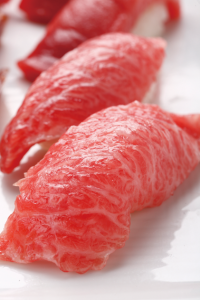 Sato is exactly what you would imagine a seasoned sushi chef to look like. Standing behind a wooden countertop, he effortlessly explains the basics of how to eat and offers tips on how to savor each fish while casually joking with his regulars. The restaurant itself is distinctly Japanese, with an understated air of sophistication. Most customers opt to sit at the counter, while some groups get cozy in handsome booths made of wood.
Sato is exactly what you would imagine a seasoned sushi chef to look like. Standing behind a wooden countertop, he effortlessly explains the basics of how to eat and offers tips on how to savor each fish while casually joking with his regulars. The restaurant itself is distinctly Japanese, with an understated air of sophistication. Most customers opt to sit at the counter, while some groups get cozy in handsome booths made of wood.
Surprisingly, the meal starts off with a small appetizer of fresh steamed clams in a tart, vinegary broth, followed by an assortment of toro (fatty tuna), kinmedai (splendid alfonsino) and torugai (a clam-like shellfish) sashimi. After the sashimi, Sato whips up a variety of dishes ranging from grilled mackerel nigiri with ponzu to shirako. However, at no point does the meal resemble the typical 8 or 10-piece salmon or tuna sets found at your average local sushi eatery.
While it’s common in most countries—including Japan—to order sushi a la carte or as part of a fixed set, Sato explains that in a traditional washoku meal, there is a set order to what you should order and when. In the most basic sense, a meal will start off with an appetizer, followed by fresh sashimi, then a simmered or grilled dish, soup, rice and a dessert. Also, depending on the chef, a course may also include fried, steamed or vinegary dishes. This is the traditional cuisine of kaiseki ryori.
“Most people are surprised to learn that the nigiri-zushi comes toward the end of a course, when they’ve already filled up on everything else,” says Sato. “So if there’s something in particular you’d really like to eat, it’s best to let your chef know ahead of time.”
Leave it to the chef
As for what fish to order, according to Sato that entirely depends on the customer. But for the ultimate sushi experience, ordering and eating the freshest fish in season is key. It may mean forgoing your favorite sushi staples, but your taste buds will thank you. Nevertheless, unless you happen to have a comprehensive sushi guide on hand, deciphering which fish are in season at any given time is a herculean task. In this case, it’s best to defer to your sushi chef, who will be more than happy to offer his recommendations. If you’re feeling particularly adventurous, just tell your chef “omakasete“, sit back and relax as your chef prepares an innovative—and sometimes surprising—selection of fish and dishes. It may be a gamble, but ordering this way often means you’ll get the freshest, highest quality fish available.
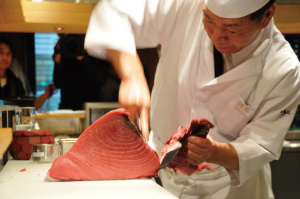 A word of caution however: not every sushi restaurant readily displays the price of each fish and ordering an omakase course may leave your wallet lighter than intended. But savvy sushi aficionados on a budget need not fear sacrificing authenticity for money. Name a price, and sushi chefs will create a menu that accommodates your budget.
A word of caution however: not every sushi restaurant readily displays the price of each fish and ordering an omakase course may leave your wallet lighter than intended. But savvy sushi aficionados on a budget need not fear sacrificing authenticity for money. Name a price, and sushi chefs will create a menu that accommodates your budget.
“You can just say, ‘I want an omakase course for about ¥5,000 or ¥10,000 yen,” says Sato. “That way you can enjoy the best fish without having to worry about the price.”
Even if you aren’t on a budget, a full course sushi dinner doesn’t have to cost a fortune. At Itamae, an eight course meal ranges from an affordable ¥3,675 to ¥5,250. But regardless of how you order your sushi, be sure to ask for the toro.
“You can tell how good a sushi restaurant is by the quality of their toro,” quips Sato.
The blue-fin tuna is a point of pride at Itamae Sushi, and matches the same quality found at other elite sushi restaurants. For the four years from 2008 to 2011, Itamae has won the prestigious first tuna auction held each year at Tsukiji Wholesale Market.
Eating sushi the smart way
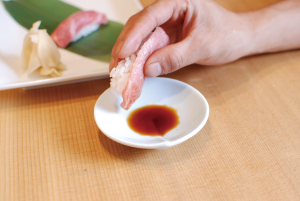
Part of the fun of an authentic sushi dinner is learning the proper ways of eating it. While it may be tempting to dig right in, taking the time to eat sushi the smart way can bring out subtle flavors and heighten your overall experience. So you might want to think twice before mixing a dollop of wasabi into your soy sauce.
“To best enjoy your sushi, tilt it 90 degrees onto its side and dip about one-fourth of the neta, or the fish side, into the soy sauce. Then, place it into your mouth fish-side down,” Sato said while deftly demonstrating the technique. After dipping it in the soy sauce, it’s best to finish the entire nigiri in one bite.
Eating sushi in this way will help prevent the rice from soaking up too much soy sauce, which will overpower the flavor of the fish and cause the nigiri to fall apart before it reaches your mouth. While the technique takes a bit of practice, once you get the hang of it, the difference in taste is immediately noticeable.
And when it comes to soy sauce, the general rule of thumb is that less is more. Sato pours a minuscule amount into our dishes—just enough soy sauce to barely cover the bottom.
“If you’re eating sushi the right way, you won’t actually need more than a few drops,” he explains. “More often than not, people end up not using all of the soy sauce they pour. Since we can’t reuse it, it’s a bit of a waste.”
Another thing many sushi enthusiasts are unaware of is the right way to use wasabi. For instance, you should never mix wasabi and soy sauce.
“I often see foreigners mix soy sauce and wasabi in their own dishes, but this just dilutes the flavor of the wasabi,” says Sato.
Unless you request otherwise, sushi chefs will include the right amount of wasabi in the nigiri itself. Furthermore, not all wasabi is created equal. Freshly grated wasabi is much milder and has a cleaner taste than its powdered or paste counterpart.
“The amount of wasabi you should use depends on the fat content of the fish,” says Sato. To demonstrate his point, he lays out a piece of ika, or squid, and toro. He explains that the fattier the fish, the more wasabi is needed to achieve the right balance of flavors. “The oil in the fish cuts the spiciness of the wasabi, so you don’t need as much of it for something like squid compared to toro.”
While simple, these tips can help add a new dimension of flavor and cultural appreciation to a culinary tradition enjoyed around the world. So the next time you step out for a nice platter of Japan’s most iconic cuisine, why not take a step back, get friendly with your chef and try a more “traditional” approach to eating sushi?
Recommended Sushi Restaurants in Tokyo
NAZUKI – Tokyo Japan Restaurant Guide
RYUDUKI SUSHI – Tokyo Japan Restaurant Guide
Tsukiji Sushi Iwa – Tokyo Japan Restaurant Guide
Tsukiji Sushi Iwa Annex – Tokyo Japan Restaurant Guide
Itamae Sushi Shinjuku Toho – Tokyo Japan Restaurant Guide
SUSHI B GINZA – Tokyo Japan Restaurant Guide
By Victoria M. Song
From WINING & DINING in TOKYO #41

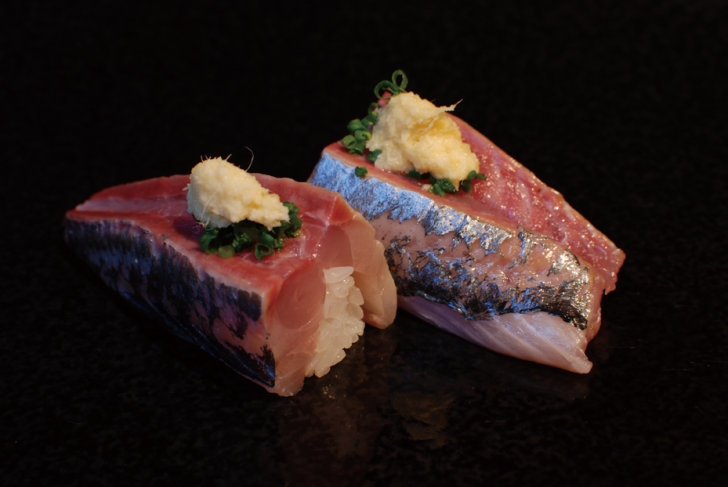



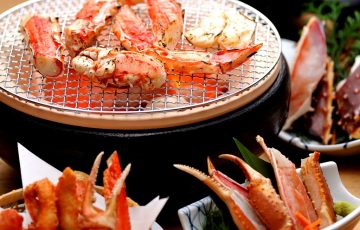


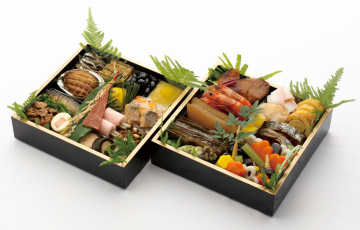
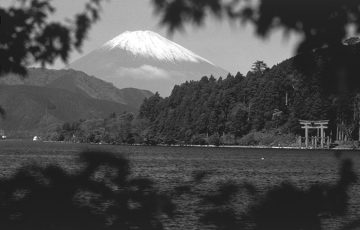

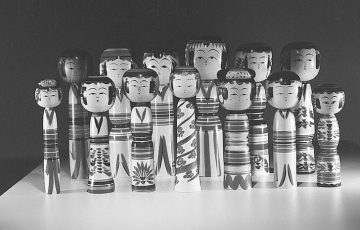



Recent Comments